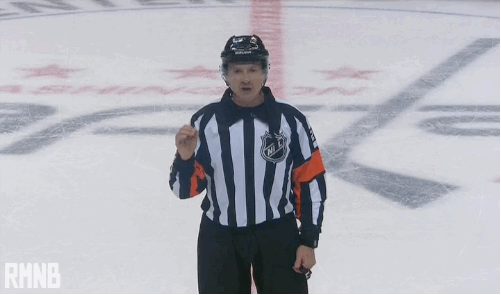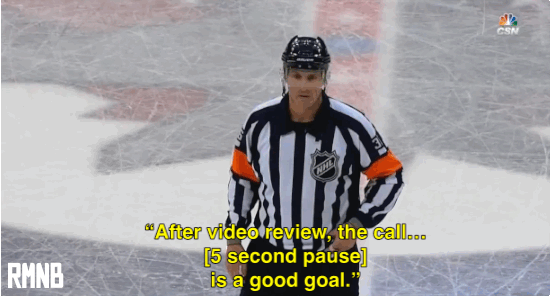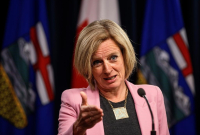Support strong Canadian climate journalism for 2025
Kinder Morgan’s self-imposed May 31 deadline to achieve political certainty for building the Trans Mountain project is rapidly approaching. And while the company has blamed the current uncertainty on the BC government’s actions to protect the coast, and the health and safety of those living here, the pipeline and tanker project still faces a great number of additional risks, including financial, reputational, and legal risks.
The 14 legal challenges currently before the Federal Court of Appeal (FCA) represent some of the most significant legal risks to Kinder Morgan’s Trans Mountain Expansion Project (TMX). This post revisits those court challenges and sets out a range of possible outcomes of that consolidated case. It also discusses recent developments related to the case.
Many Canadians are watching the Stanley Cup hockey playoffs right now, so we are enlisting the help of hockey referees to help explain the possible scenarios. Ready? Let’s drop the puck!

Gif Credit: GIPHY
Recap:
In a previous post on West Coast Environmental Law's website, I discussed the court challenges over the federal approval of Trans Mountain and summarized the arguments made at the two-week-long hearing in Vancouver in October 2017. These legal challenges to the National Energy Board (NEB) recommendation and federal Cabinet decision in 2016 fit into two broad categories: (1) constitutional duties related to Aboriginal rights and the duty to consult; and (2) legal errors based on a failure to follow legislation or common law precedent.
Our best guess for the timing of a decision from the FCA has been June 2018, but recent developments may change that timeline. More on that below.
So what could the court do? Here is the range of outcomes from the FCA cases.
Note: these are not ranked for likelihood – don’t believe any lawyer who tells you they know what any court will decide before the decision comes out.
1. Appeal allowed: Cabinet decision quashed (cancelled) because NEB process was flawed and not corrected, and consultation was not meaningful

Gif Credit: GIFER
In this scenario, the court would agree that some or all of the legal errors argued by applicants were legitimate and not corrected by Cabinet, and that consultation with one or more of the First Nations was inadequate. This would send the decision back to the federal government to correct the legal errors and to re-engage in consultation. It could mean that the project review gets sent back to the National Energy Board (NEB) or Canadian Environmental Assessment Agency, and additional meaningful consultation and accommodation with First Nations happens.
The primary argument about consultation by First Nations was that it was not a two-way street, and that government approached consultation with their minds already made up while saying that a decision had not yet been made. If this argument is upheld, then the future consultation would have to ‘reset’ completely – not just be a longer, more expensive process without any meaningful accommodation.
As the court said in Gitxaala Nation v. Canada (the case that overturned the Enbridge Northern Gateway project), Cabinet would have to make a fresh decision. By looking at the matter afresh, deficiencies identified in the previous process could result in additional conditions or process, or even a rejection of the project
2. Appeal allowed: Cabinet decision quashed due to flawed consultation, but NEB process and other legal errors were OK, or are not reviewable

Gif Credit: GIPHY
Here, the court would find that the NEB process was not reviewable, since it wasn’t the final decision, (or that the legal errors alleged are OK) but that the federal government’s duty to consult was not met for any one of the six First Nations.
As we have written before, in Canadian law, each nation has an independent right to be consulted at a level consistent with their strength of claim and impact of the project on their inherent rights. That means that a finding of adequate consultation for one or several First Nations does not guarantee that it would be found for all First Nations.
If the court were to find that the consultation did not meet the standard in Canadian law (‘upholding the honour of the Crown’), they might offer direction on how Cabinet could correct those errors. Like in Gitxaala, it would then be up to the federal government to reopen its consultation process and make any accommodation measures that arose from that consultation. These measures could include a route change, risk mitigation measures, compensation infringing on rights and title, or rejecting the project.
In Gitxaala, the FCA stated that the federal Cabinet would have to make a fresh decision, and had three options: (1) direct the NEB to reconsider the recommendation and correct errors; (2) direct the NEB to add terms and conditions that corrected the errors; or (3) direct the NEB to dismiss Kinder Morgan’s application. The court was clear to state that the fresh redetermination could only happen after the duty to consult, accommodate and seek consent from Aboriginal peoples had been fulfilled.
3. Appeal allowed: Cabinet decision quashed because of statutory errors by the NEB or Cabinet

Gif Credit: Tenor
Here, the court would find that the statutory errors by the NEB (i.e. excluding marine shipping from the review, issues with procedural fairness, failure to implement the Species at Risk Act (SARA), failure to issue adequate reasons etc.) were not corrected by the Cabinet when they made their decision – and the Cabinet decision is therefore quashed.
It is possible that if the court found this error upfront, it would not rule on the consultation question, and just send the decision back to Cabinet to correct the statutory errors. The correction would depend on which of the several alleged errors the court agreed with, and which body (NEB, Canadian Environmental Assessment Agency, Cabinet or other) could correct those errors, as set out above.
4. Appeal allowed: Cabinet decision quashed because even though consultation was meaningful, infringement of confirmed rights was not justified

Gif Credit: GIPHY
Here, the court might find that the federal government met the standard for the duty to consult but failed to justify the infringement of established Aboriginal rights – specifically the Sto:lo applicant’s rights following the VanDerPeet decision, which confirmed an Aboriginal right to fish for Sto:lo. As with Gitxaala, using a similar approach for all affected First Nations could be a fatal flaw, given the project’s different impacts on each nation’s rights.
The court might order the federal government to engage in more meaningful discussion with the rights holders, and either justify or compensate for the infringement of rights (or a combination of both), or failing that, reject the project altogether based on an unjustified infringement of rights.
5. Appeal dismissed: Consultation was meaningful and the NEB process was fine

Gif Credit: Imgur
In this scenario, the court would have to find that consultation for each of the six First Nations challenging the NEB and Cabinet decisions was meaningful and that there were no additional legal errors made (i.e. the decision and process followed applicable legislation and common law). In other words, Canada, Kinder Morgan, and the NEB would combine for a 1.00 save percentage, to use a hockey analogy (or 1.00 batting average in baseball). In this case, the Cabinet decision would stand and the approvals would remain in place.
6. Appeal dismissed: the NEB process was flawed, but consultation was meaningful

Gif Credit: GIPHY
Here, the court agrees the NEB made one, several or all of the statutory errors that the applicants complain about in the NEB process. But despite these errors, the court finds that the consultation efforts by the federal government were meaningful, and declines to quash the Cabinet decision.
It is possible that the court orders additional work to correct the NEB’s legal errors. For example, it could direct Cabinet to re-do the marine shipping review under the Canadian Environmental Assessment Act, 2012, or to come up with a recovery plan for southern resident orcas consistent with SARA, while maintaining the Cabinet decision.
7. Appeal dismissed: the NEB process was flawed and there were flaws in consultation, but since consultation is reviewed on a ‘reasonableness’ standard, Cabinet decision is upheld

Gif Credit: GifGoldMine.com
Here, the court could say something like: “While Canada’s consultation could have been better, the law does not require that Canada undertake perfect consultation – only that its consultation be reasonable…in the circumstances of this complicated project, Canada met that standard.”
The court may even identify specific things Canada could have done better, and note that there will be future opportunities to address concerns, despite dismissing the judicial reviews. This is known as the dreaded ‘future consultation’ argument. In this case, the Cabinet decision would remain in place.
Developments since the October hearing dates
In the seven months since the hearing at the FCA, a lot has happened. In particular, Justin Trudeau stated in an interview that the decision on Kinder Morgan was made as a tradeoff for the Pan Canadian Climate Plan, suggesting that the project was approved in principle before consultation was complete (and even before the NEB made its recommendation).
In April 2018, investigative reporter Mike De Souza released a series of articles based on documents obtained through access to information laws and inside government whistleblowers. These articles concluded that the approval process was rigged and that senior officials were instructed to “find a legally sound basis for yes” while the consultations were ongoing.
This story added weight to what the First Nations had been saying throughout the FCA challenge: that consultation was not meaningful because it was a one-way street. It also backs up the First Nations’ assertions that contrary to what they were being told during consultation, decisions had already been made about the project.
As a result of these developments, Tsleil-Waututh Nation (TWN) filed a motion with the FCA to re-open the evidentiary record and have Canada produce uncensored versions of the documents from the media stories. The TWN motion stated:
[The documents] strike at the core of an issue central to these proceedings: namely, whether the honour of the Crown was upheld by Canada during its consultations with TWN in connection with the Trans Mountain Expansion Project, […]
The documents establish that it did not; rather they corroborate grounds, evidence, and argument that TWN has already advanced in these consolidated proceedings: that (i) Canada’s representatives had an insufficient mandate — limited to listening to concerns and recording them, and (ii) Canada proceeded during that time and in approving the Project with a constitutionally-impermissible ‘closed mind’ or a ‘mind made up.’
On May 11, 2018 Canada responded to the TWN motion, after warning of significant delay. Canada stated:
To re-open an already concluded hearing while a matter has been under reserve for a considerable period of time is an exceptional procedural step, one that has the potential to cause significant prejudice by delaying adjudication of pending litigation and prolonging uncertainty. […]
TWN should not now be permitted to revive its efforts to compel production of these documents long after the hearing has concluded, especially when the documents sought are not of a kind that would assist the Court to fairly adjudicate these applications. This is particularly the case when to do so has the potential to cause significant delay and prejudice to both the parties and the public who are awaiting adjudication of these important applications.
Tsleil-Waututh Nation had until May 17 to file a reply to Canada’s response, and then the FCA will rule on the motion for fresh evidence. If the motion is granted, then Canada will have to produce the requested documents and there may be further argument on how this evidence changes the case. If the motion is dismissed, then the case will remain under reserve, with the panel likely drafting reasons to be released in the coming months.
Whatever happens at the FCA in the coming weeks, it is certain that lawyers on both sides will look very closely at an appeal to the Supreme Court of Canada, which is ultimately where this pipeline and its approvals seem destined to end up. This would add months, if not years, of further delay.
For a fascinating account of how De Souza came into possession of these documents, check out this episode of the CANADALAND podcast.
What will happen on May 31?
This is the big question everyone is asking. But remember, the May 31 deadline is also a self-imposed and arbitrary date for Kinder Morgan to achieve political certainty. It is also important to remember that political risk and legal risk (not to mention financial risk and reputational risk) are separate conditions for moving forward with Trans Mountain.
So, we’ll leave the last word to Kinder Morgan CEO Steve Kean, who stated when asked about the FCA cases in an investor call: (at 21:30, registration required):
"[W]e believe that the federal government [in approving the Kinder Morgan project] followed the previous precedent [set by the Federal Court of Appeal] which was Northern Gateway and tailored all the work that they did: the additional environmental work, the marine response program, First Nations consultation, etcetera etcetera to tack to what we were told to do in Northern Gateway. We believe our arguments do the same; we think we have a very good case, right?
But if that appeal has an adverse outcome, meaning that the order in council is overturned on appeal then that means the whole underlying approval and basis for this project has gone away.
So it is its own condition that is sitting out there that still needs, even if we have other things in place, we still need to see a resolution of that.
It would also be very concerning if, for example, that order comes back at it send us back to do more work, right, so that if the order in council is largely affirmed, but then there are one two three things that need to go have further record developed, additional time spent, additional conditions perhaps imposed and then those go up on appeal too, that's just, I think, that's just too much to bear given the point where we are. So it is a separate thing that we have to watch for and see a satisfactory result on, on the judicial review. (Emphasis added)"
This article was originally published by West Coast Environmental Law






Comments